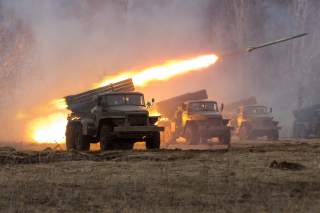Meet Russia's Killer Robot Rocket Launcher
A Russian defense official suggests the possibility of a fully automated multiple launch rocket system or MLRS.
Robo-Katyusha is coming.
A Russian defense official suggests the possibility of a fully automated multiple launch rocket system, or MLRS.
"If we look at first-generation [Russian MLRS] systems, be it Grad or Tornado, they, of course, possess some minimal tools of automation,” Alexander Smirnov, managing director of NPO Splav, a state-controlled manufacturer of rocket artillery, told Sputnik News. “It's difficult to determine the percentage of robotization in a particular complex or system. But I can say with confidence that the systems created in recent years, including the Tornado-G and Tornado-S, have already implemented components which can become the foundation for a promising robotized MLRS.”
Smirnov noted that existing rocket launchers like the Tornado-S already have some degree of automation for guidance and fire control, as well as automated equipment to prepare and launch the rockets.
"This allows us to automate the preparation process, and to control the guidance of the launch package, and the firing itself, and to carry out automatic topographic positioning and orientation of the combat vehicle on the ground, to remotely enter flight mission data into the fuses and launch projectiles without the crew having to leave their cabin," Smirnov said.
It’s not clear what Smirnov means by “automation.” Modern weapons like tanks and artillery often have some degree of automation, such as autoloaders to speed up the rate of fire, or automatic countermeasures to stop incoming rockets. Nonetheless, if Smirnov is suggesting a fully autonomous multiple rocket launcher, then that takes automation to a much more challenging level. A true MLRS would first have to be a self-driving truck, able to navigate around obstacles (and do so under fire). It must be capable of operating in formation—such as road convoys—with friendly forces without colliding with other vehicles or running over personnel.
In turn, this requires a sophisticated AI and comprehensive situational awareness. It also requires a reliable communications system, because a multiple rocket launcher needs to know its precise location and the location of the enemy.
Which brings up the biggest issue: command and control. Presumably, an automated rocket launcher would not be able to fire without a human in the loop to give the command. If so, then Robo-Katyusha will lack the flexibility of a human crew to respond to emergencies, such as self-defense under attack, or providing fire support to friendly troops even when communications are down.
In other words, Russia would have to solve all the issues that Google and Tesla are facing with self-driving cars, if those cars carried a ton of high explosives.
None of which is impossible. But then again, a self-driving car that suffers a software failure may mow down an unfortunate pedestrian or bicyclist. An AI-controlled multiple rocket launcher can annihilate an entire village with a single salvo.
But if this idea works, then maybe Google will be asking Russia for advice on how to make self-driving cars.
Michael Peck is a contributing writer for the National Interest. He can be found on Twitter and Facebook.
Image: Wikimedia Commons.

